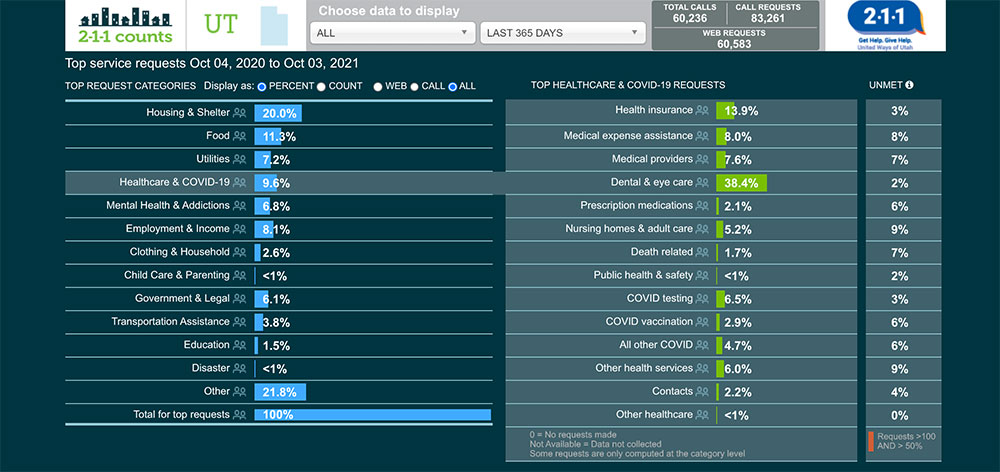Use 211 Data to See the Greatest Needs In Our Community
Utah 211 is a statewide health and human services referral system. It’s a simple, one-stop way to connect people with resources that can help with needs such as housing and utility assistance, food supplies, transportation, childcare, and more.
The number and type of service requests 211 receives are collected, keeping personal information anonymous. To make the data accessible, useable, and available daily, 211 Counts was created.
211 Counts allows you to see exactly what you’re looking for — you can view the top requests for services by category (like housing, healthcare, food & utilities), you can break down how many of the requests for a referral weren’t met (either because the service doesn’t exist or the caller has exhausted the service), and you can filter the results by time frame, region, zip code, county, and even congressional, state, and house districts.
All of this is designed to make sure the right data reaches the right people at the right time. If you’re curious, want to know where resources are most needed, or need specific data points for your communications, 211 Counts can help.
What Information is Available
1. Total Number of Calls, Call Requests, and Web Requests
At the top of the page, 211 Counts displays the total number of calls made to our 211 Information Specialists; the total number of call requests, as one person may want to be connected to multiple resources; and the number of web requests within a certain time frame.
2. Top Service Requests
Seeking everything from rental assistance to opioid misuse resources, Utah residents call 211 for a variety of reasons. These needs are shown within larger categories to track the top service requests in our state, then broken down into smaller categories to give a 211 Counts user more information into what information was requested and whether or not 211 was able to provide the caller with a resource that met their need. See the breakdown by clicking on the category title. Clicking on the category will also change the map to show where in the state has the highest number of requests within that category.
3. The Number of Unmet Requests
The column on the right displays “unmet requests.” This is the percentage or the number of a type of request for which no resource was available when someone called or contacted 211. Unmet requests occur for a variety of reasons, including no available resources in the vicinity of the requestor or the requestor failing to qualify for available resources due to their demographics (e.g. some organizations offer assistance only to those with children, those below a certain income level, etc.). Unmet requests allow legislators and organizations to see where they should invest in their communities to best help fill the gaps in service their community is experiencing.
Apply Filters
1. Search by Zip Code or County
Learn about the greatest needs in your neighborhood by filtering by zip code or county. You can select multiple zip codes or counties at once.
2. Search by Congressional, State, or House District
Built for legislators or for talking with your representatives, filtering by congressional district or state district displays the greatest needs of constituents. This information can be used to better determine where to allocate funds, see what services need to be created or expanded to address unmet needs, and more.
3. Change the Timeframe of Your Search
211 Counts is updated daily, giving users real-time access to information about the requests being made by the community. You can set the timeframe filter to see requests from yesterday, from the last 30 days, even for the past year or more.
Export a Report
Whether you want to email it to your colleagues or share it on social media, 211 Counts allows you to export a detailed report with a set of custom filters. Click the icons on the side to share the data you find most useful.
Get started with using 211 Counts by visiting ut.211counts.org. If you need assistance finding resources in Utah, call 211 or visit 211utah.org.


